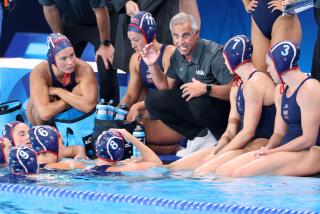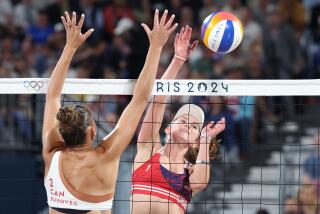U.S. Can’t Get Set at Setter : Lack of Solid ‘Quarterback’ Hurts Volleyball Rebuilding Effort
SAN DIEGO — Several years ago, Terry Liskevych, the U.S. women’s volleyball coach, gave a warning disguised as a speech to members of the American Volleyball Coaches Assn.
His topic? “A crisis at quarterback.”
Liskevych was referring to the United States’ relative dearth at the setter position, especially in youth programs and high schools. The problem has now reached the point that the U.S. team is far behind its international counterparts in what is possibly the most important position.
“I really think that there is a crying need for better setters in this country,” Liskevych said. “It’s still not an above-average skill (on the U.S. team). We still have to look after that position.”
So why, when several hundred thousand girls play high school volleyball, are there no dominant players at setter?
Liskevych now says the same thing he told his audience several years ago.
“There are maybe 6,000 to 8,000 boys playing high school volleyball and around 300,000 girls,” Liskevych said. “The men have always had pretty good setting.
“What happens is that boys recognize the importance of the position and the best athletes become setters. Which is different than girls. A high school coach looks at the team and says, ‘Who can’t hit? I’ll make them the setter.’ ”
The lack of national depth at setter was even more obvious when Liskevych was forced to pull 34-year-old Laurel Brassey-Kessel out of retirement to set for the United States during the 1988 Olympics. Even though Brassey-Kessel was past her prime, she was still the best available.
After the Games, the position was still a major question.
Liskevych had three setters to start the year. Wendi Rush (Stanford) and Lori Endicott (Nebraska) were both college All-Americans, and Julie Bremner was an unknown who left Notre Dame after her freshman year to try out for the U.S. team.
That number was quickly reduced to two when Rush had a complete tendon graft on her right knee. She is not expected back until early next year. While Endicott has more experience, Bremner has come on strong.
“We’re expecting virtually two rookies to come in and be the quarterback of our team,” Liskevych said. “And that’s very tough at our level.”
But this is far from the only problem the U.S. women’s team has had to deal with in a year that was supposed to re-establish it among the world’s elite after a disappointing ’88 Olympics.
First there was a rash of injuries Liskevych said he has never encountered in his years of coaching.
Then there was the trip to China, during which the U.S. team members brushed ever so slightly against history as they tried to make their way through student roadblocks in Beijing several days before the massacre at Tiananmen Square.
The team finally seemed to be settling down when, 2 1/2 weeks before the crucial NORCECA Zone Championships, Caren Kemner--the mainstay of the American offense--unexpectedly announced her retirement.
“Our goal for 1989 was to establish ourselves as the fourth or fifth best team in the world,” Liskevych said. “The top three--the Soviet Union, Cuba and China--are a given. The next group is Peru, Japan, East Germany, Brazil and the USA. We wanted to be the best of that group.”
And the United States looked as if it were heading in that direction when it easily won the Canada Cup in March, defeating Canada--which it is playing in four matches in the San Diego area this week--and B teams from Cuba (twice) and China without losing a set.
Then came the injuries, the most notable resulting in major knee surgery for outside hitter Ruth Lawanson and Rush.
“It’s been a tough 2 1/2 months,” Liskevych said. “Just the instability of our lineup. There are so many new faces. It’s part of the game, but in all my years of coaching I have never had so many acute injuries.”
They turned out to be an omen for the U.S. team as it headed to China for two tournaments.
The Americans arrived in Beijing during the height of the student protests at the end of May. As their bus attempted to make its way through the blockades at 3 a.m., they were stopped 10 or 12 times by the students.
“It was novel at first,” Liskevych said. “But you never know. You have young students asking who you are. Somebody might want to make a name for themselves. But what was evident to me was that they were unarmed. That case was well made when the army came into Tiananmen Square.”
The U.S. team went on to lose twice to China and split two matches with Japan. But it had six weeks to prepare for the important NORCECA Zone Championships. The United States needed to finish first or second to Cuba to earn a berth in the World Cup in November at Japan.
The Americans looked to be in good position to finish second. Its chief competitor would be Canada, a team they had dominated in recent years and that they had beaten four out of five times this year.
But just before the tournament, Kemner decided to retire.
“It was a surprise,” Liskevych said, “although I know that there has always been a question in Caren’s mind, ‘Should I be playing volleyball?’ “When she plays well, she can play better than anybody in the world. Caren was our standard-bearer.”
Liskevych talks about no player being indispensable, no part being greater than the whole. But when Kemner quit, it definitely left a hole.
The U.S. ended up losing, 3-1, to Canada in the semifinals at NORCECA, which knocked them out of the 16-team World Cup.
“I think we took a step back in losing to Canada,” Liskevych said.
Liskevych hopes to regain that step and a few more next year. He is optimistic about a new crop of players that will try out for the team in January, including Long Beach State’s Tara Cross and Hawaii’s Teee Williams.
“January 1990 is going to be a real critical phase for this program,” Liskevych said. “We’ll have to make some hard decisions. There’s definitely players out there who can help us.
“We don’t want to just be a national team. But if there is anything I’ve learned, it’s that anything of quality takes a long time to develop.”
More to Read
Go beyond the scoreboard
Get the latest on L.A.'s teams in the daily Sports Report newsletter.
You may occasionally receive promotional content from the Los Angeles Times.






